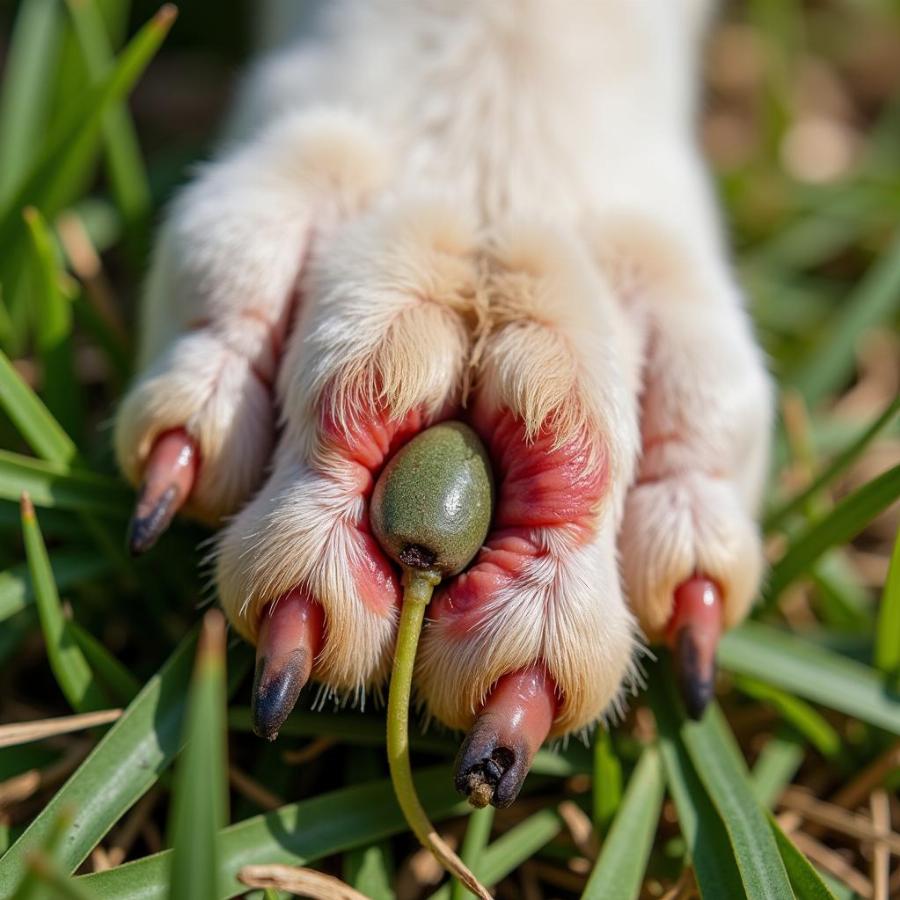Grass seeds can be a real nuisance for our furry friends, especially during the warmer months. These tiny, seemingly harmless seeds can easily become lodged in a dog’s paw, causing significant discomfort and potentially serious health problems if left untreated. This guide will provide you with everything you need to know about grass seeds in dog paws, from prevention and identification to removal and aftercare.
Identifying a Grass Seed Problem
How can you tell if your dog has a grass seed in its paw? Dogs often exhibit telltale signs, including excessive licking or chewing at their paws, limping, or holding the affected paw up. You might also notice redness, swelling, or discharge around the affected area. If your dog is displaying any of these symptoms, it’s crucial to inspect their paws carefully.
What to Look For
Look for a small entry wound, often between the toes or pads. Sometimes, you might even see the tip of the seed protruding. Be aware that the seed may have already burrowed beneath the skin, making it invisible to the naked eye. In such cases, the area will likely be inflamed and tender.
 Dog paw with a grass seed embedded
Dog paw with a grass seed embedded
Removing a Grass Seed
If you locate a grass seed, try to remove it yourself if it’s easily accessible. Use tweezers to gently grasp the seed and pull it out in the direction it entered. However, if the seed is deeply embedded or you’re unsure how to proceed, it’s best to seek veterinary assistance. Attempting to remove a deeply embedded seed yourself could worsen the situation. A veterinarian has the necessary tools and expertise to remove the seed safely and minimize the risk of infection.
Veterinary Removal
Your veterinarian may use specialized instruments to locate and remove the seed. In some cases, sedation or local anesthesia may be necessary. After removal, your vet will likely clean the wound and prescribe antibiotics to prevent infection.
Preventing Grass Seeds from Becoming a Problem
Preventing grass seeds from embedding in your dog’s paws is always the best approach. Here are some preventative measures:
- Keep your lawn mowed short: Shorter grass means fewer seed heads.
- Avoid walking your dog in areas with long, dry grass, especially during seed-shedding season.
- Consider using dog booties: Booties provide a physical barrier against grass seeds and other potential hazards.
- Regularly check your dog’s paws: After each walk, inspect your dog’s paws for any signs of grass seeds or other foreign objects.
Home Remedies for Minor Irritation
If you suspect a grass seed is causing only minor irritation, you can try soaking your dog’s paw in warm water with Epsom salts. This can help soothe the area and may even draw the seed out. Remember, if the problem persists or worsens, consult a veterinarian. You might also find helpful information on swollen dog paws home remedy on our website.
Long-Term Care and Monitoring
Even after the grass seed is removed, it’s essential to monitor the affected paw for any signs of infection, such as increased redness, swelling, or discharge. If you notice any of these signs, contact your veterinarian immediately. If you’re concerned about lawn fertilizers and their impact on your dog, check out our article on lawn fertilizer safe dogs.
When to Seek Veterinary Help
- Persistent licking or chewing: If your dog continues to lick or chew at their paw despite your efforts to deter them, it’s time to see the vet.
- Visible swelling or redness: These are signs of inflammation and potential infection.
- Limping or favoring a paw: This indicates pain and discomfort.
- Discharge from the paw: Discharge can be a sign of infection.
- Inability to locate the seed: If you suspect a grass seed but can’t find it, a veterinarian can help.
Frequently Asked Questions (FAQs)
- What types of grass seeds are most problematic for dogs? Foxtail grass seeds are particularly notorious due to their barbed structure, which allows them to burrow into skin and tissue.
- Can grass seeds migrate to other parts of the body? Yes, if left untreated, grass seeds can migrate through the body, causing serious complications.
- Are certain breeds more susceptible to grass seed problems? Long-haired breeds are often more susceptible, as the seeds can easily get tangled in their fur.
More Helpful Resources
- Check our article about dog ear itching for more information on paw and ear health.
- If your dog is experiencing respiratory issues, our article on dog coughing and wheezing might be helpful.
- For insights into other common ear problems, see our article on small brown in dogs ear.
Conclusion
Grass seeds in dog paws can be a painful and potentially serious problem. By taking preventative measures, regularly checking your dog’s paws, and seeking veterinary care when necessary, you can keep your furry friend happy and healthy. Remember, early detection and prompt treatment are key to minimizing discomfort and preventing complications.
Beaut Dogs is your one-stop resource for all things dog-related, from breed information to health and care tips. We are committed to providing valuable, insightful, and in-depth information about the canine world. For further assistance or detailed, accurate information, please contact us via Email at [email protected]. Beaut Dogs is here to help you navigate the wonderful world of dog ownership and ensure the well-being of your beloved companion. Visit us at https://beautdogs.com.